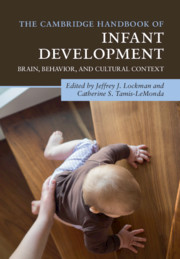Book contents
- The Cambridge Handbook of Infant Development
- The Cambridge Handbook of Infant Development
- Copyright page
- Dedication
- Contents
- Illustrations
- Contributors
- Preface
- Part I Foundations
- 1 Embodied Brain Model for Understanding Functional Neural Development of Fetuses and Infants
- 2 Infant Physical Growth
- 3 Dynamic Epigenetic Impact of the Environment on the Developing Brain
- 4 Brain Development in Infants
- 5 Development During Infancy in Children Later Diagnosed with Autism Spectrum Disorder
- Part II Perceptual Development
- Part III Cognitive Development
- Part IV Action
- Part V Language
- Part VI Emotional and Social Development
- Index
- References
4 - Brain Development in Infants
Structure and Experience
from Part I - Foundations
Published online by Cambridge University Press: 26 September 2020
- The Cambridge Handbook of Infant Development
- The Cambridge Handbook of Infant Development
- Copyright page
- Dedication
- Contents
- Illustrations
- Contributors
- Preface
- Part I Foundations
- 1 Embodied Brain Model for Understanding Functional Neural Development of Fetuses and Infants
- 2 Infant Physical Growth
- 3 Dynamic Epigenetic Impact of the Environment on the Developing Brain
- 4 Brain Development in Infants
- 5 Development During Infancy in Children Later Diagnosed with Autism Spectrum Disorder
- Part II Perceptual Development
- Part III Cognitive Development
- Part IV Action
- Part V Language
- Part VI Emotional and Social Development
- Index
- References
Summary
The development of the brain in humans following birth is one of the most remarkable changes in human growth. The structure, myelination, and connectivity of the brain are relatively primitive at birth. Much of the development of the size, shape, and connectivity occurs after birth and before the end of the second year of life. The brain appears in size and shape similar to the adult brain at 2 years of age. The brain continues to change and develops over the entire life span, although the changes after 2 years appear to be more quantitative and gradual than the changes in the first 2 years. Some of the brain changes are from intrinsic growth factors governed by maturational factors, whereas other brain changes are affected by individual experiences and background setting. The interplay of intrinsic and extrinsic forces shapes the brain through the life span.
Keywords
Information
- Type
- Chapter
- Information
- The Cambridge Handbook of Infant DevelopmentBrain, Behavior, and Cultural Context, pp. 94 - 127Publisher: Cambridge University PressPrint publication year: 2020
References
Accessibility standard: Unknown
Why this information is here
This section outlines the accessibility features of this content - including support for screen readers, full keyboard navigation and high-contrast display options. This may not be relevant for you.Accessibility Information
- 7
- Cited by
